#chinese resources
Text
Welcome to linghxr
For my 250th post on this blog, I created a new pinned post to introduce myself!
About me:
I’m a Chinese American learning Mandarin Chinese to connect with my family and heritage.
I started learning Chinese at a young age but became more serious about it in college. My native language is English.
Interests: Cpop/Mandopop, Chinese idol survival shows & reality singing shows, cdramas (mostly suspense/mystery/crime genres)
My top resources:
Pleco Chinese dictionary app
Anki flashcard software & mobile app
MDBG Chinese dictionary
教育百科 Chinese dictionary
Zhongwen browser extension
Readibu app
Chinese Grammar Wiki
Chinese Zero to Hero YouTube channel
每日中文课Free To Learn Chinese YouTube channel
If you are on my blog, click the tags below to see posts on topics I often post about!
#vocab list#chinese names#chinese resources#chinese music recs#chengyu#my watchlist#my learning#nerdy language stuff#culture stuff
348 notes
·
View notes
Text
it’s interesting to me when people on tumblr who are learning chinese say you don’t need to learn radicals, because………i just don’t think that’s true? as someone who grew up speaking and learning it natively i may be biased, but there’s just…….so many situations when knowing at least basic radicals and meanings is very useful.
if you’re in an area that uses traditional or simplified and you’re used to the opposite set, then knowing radicals can be key to understanding the written language on signs in the area, menus, letters, etc. if you’re reading something and you know the meaning of the characters around a new character, but you don’t know what that character is because it’s unfamiliar to you, knowing radicals allows you to make a guess at the meaning of the character and possibly connect it to the spoken version of the character that you already know based on that context, as for example a radical often lends pronunciation clues to a character.
also, knowing radicals makes it much easier to remember how to write characters—it’s much easier to remember, say, 想 as wood-and-eye-over-heart (木目心) or 绿 as silk-record (silk radical 纟plus the word 录 as in 录音, audio recording) because those are patterns you already have than to remember the individual strokes necessary to write a character. and on the topic of writing—knowing radicals also tells you the order in which to write a character, which is absolutely key to writing legible, orderly characters in a minimal amount of time!
obviously the measure of how many radicals you “really” “have to” know is going to vary by the person you talk to, but i think it’s important to have at least a passable basis in radicals if you’re going to learn chinese, a language written with radicals as important components of words.
and, lest i be remiss—here’s some resources i managed to find with a quick search.
hackingchinese page on radicals with a number of links to .anki, .txt, and .pdf files of the 100 most common radicals
hskacademy list of 214 radicals
a fluentu page that includes 214 radicals and expounds upon the meaning of phonetic and semantic components and their difference from radicals
ltl-beijing page that includes links to a list of radicals, some history behind them, a quiz, printable pdf, and more
and finally, not a link, but a recommendation for an app: download TOFU learn and use the hsk level decks! this is a very easy way to get into the habit of writing and repeating characters daily, which is absolutely vital if you want to get anywhere with reading and writing. dot languages also has a written component to practices, but the app is multi-functional and not confined to writing, nor does it give information about component and radical meanings like TOFU learn does. additionally, i would recommend downloading pleco, which is a very thorough dictionary that has the option to view the radical/component breakdown of a given character (under the “chars” tab—for example it breaks down 音 as 立 and 日) i’ve also seen skritter recommended a lot, but i cannot vouch for that.
#chinese langblr#mandarin langblr#chinese language#chinese resources#langblr#langblr resources#this was originally all one chunk of text but i’ve broken it up to make it easier to read#i hope this comes off as attempting to be helpful rather than patronising#because i genuinely want to help!#and i think if you have no heritage ties to chinese it’s DOUBLY important you learn at least a few radicals#because unlike chinese-born/raised kids you don’t have a basis or background to fall back on#and you’re at a disadvantage if you ignore that#汉语#indigostudies#resources#indigo ink
197 notes
·
View notes
Text
The 4 Classic Novels of China— Easy Mode
I’ve mentioned several times how important the classic novels are to learning Chinese, but like classic English novels, they’re not incredibly accessible due to their old-fashioned and highly literary writing. I collected a few options for people who want to read these novels, but aren’t at the level required for the original versions.
The Journey to the West Series by Jeff Pepper and Xiao Hui Wang
This is the one that I have personally used out of this list. This version of 《西游记》begins at a 600 word requirement, but as the story goes on, grows to 2,000 words. All of the volumes have been published and come in MANY formats. Not only is this available in Simplified and Traditional, it’s available as individual books, collections, and an omnibus edition—all of which are in print, ebook, and include an online audiobook.
The book is formatted as one page is pinyin, one page is Chinese, and an English translation and glossary in the back of the book. I think this is a nice format as everything is there, but there’s also enough control to read it with the least amount of aids. I really hope the other classics get adapted as this really set a solid standard for this style of learning material.
Sinolingua Press
This will contain two series published under Sinolingua Press that contain the same books, but with differences!
Abridged Chinese Classic Series
This is exactly what it says! It is the four classic novels that are abridged. All of these are geared towards an expected HSK 5 (pre-HSK 3.0) 2,500 word level.
Rainbow Bridge Graded Chinese Reader
This series includes the four classic novels as well as other stories such as Butterfly Lovers, Legend of the White Snake, Hua Mulan, Nüwa, and Romance of the West Chamber. For the classics, 《西游记》and《水浒传》are at 2,500 word level and 《红楼梦》and《三国演义》are at the 1,500 word level.
Now, I’m not sure what the difference is between 《西游记》and《水浒传》in the first series and this series. Format wise, both use pinyin above the Chinese (a special bookmark is included if you want to block the pinyin). If you’re like me and do judge books by their cover, the Abridged Classic series is a very pretty set! Some of the Graded Chinese Reader books have received updated cover art that looks great, but it’s not across the whole series. From what I can tell, the Abridged Chinese Classic Series is for an older audience as it doesn’t have the cartoon illustrations. All of these novels are in Simplified Chinese.
Comparisons and other options
The Sinolingua versions are HIGHLY abridged. For comparison, the Pepper/Wang version is over 10 times longer than both of the Sinolingua versions. All of the versions of the classics come in around ~300 pages when the originals are multi-volume novels. This isn’t inherently bad, and is common in the last option: Chinese children’s version. There are multiple publishings in this style and these also tend to be around the same length. They have their own benefits and drawbacks. The Chinese editions will not include any English and aren’t tailored to the HSK style, but reading age.
Final Thoughts
Of the four options, it’s all about personal preference and what you want in a book. I hoped this was of some help! Books mentioned above can be found on Amazon (Pepper/Wang), Purple Culture (Sinolingua), and Aliexpress (Sinolingua/Chinese Published versions).
102 notes
·
View notes
Text
I found this tool for practicing tone pairs, both saying them and identifying them. Its free and works on phone or computer, I like it for a quick way to test yourself and practice to improve.
12 notes
·
View notes
Text
I have just discovered a new app for reading practice and it looks pretty good!

It's called Dot and it has short dialogues, several of which are based on current news topics, from beginner to advanced levels.
The levels are based on the new HSK.3 so level 1 is hard for a newbie, but pretty readable for my current level (between 2 and 3 in HSK.2).
There are vocabulary exercises you can do after you read each text, and they unlock other (presumably slightly more challenging) texts. But even if you don' do the exercises, there is plenty to read and new texts are added often.
I found 2 issues with the exercises: sometimes you have to choose the pinyin for the character, but the option available is for a different meaning of the same character (for example, the character was 行 xíng but I had to click on "háng", even in a listening exercise when the audio clearly said "xíng"!), and there are writing exercises but on my device, when I tried to write, it would scroll up/down instead so I gave up. But you can turn off the writing and listening exercises in the settings.
133 notes
·
View notes
Text
If you're learning Chinese and at the intermediate/proficient level, here are some resources you can use to improve:
language
for 成语s: zaojv.com
for definitions: baidu.com
for dictionary: Pleco
books
4 classics (四大名著): 三国演义, 西游记,红楼梦,水浒传
others: 聊斋志异
social media
- 小红书
- 微博
.
.
.
.
.
大家好!希望你生活过得十分愉快!可是,就算你度日如年,你也必须记得:人无千日好,花无百日红,天下没有不散的筵席。
继续加油哦。我现在在学德语(Hallo, wie geht es Ihnen? Ich kann ein bisschen Deutsch sprechen... Chinesisch mag ich sehr, und Sie?),学习新的语言并非容易,所以我们要一起努力,好吗? (你们要回答:嗯嗯嗯) 学习华文时,一定会遇到不少的挫折。但所谓“一分耕耘,一分收获”,只要你坚持到底,不肯放弃学习华文,一定能克服困难,得到梦寐以求的“收获”。
祝
学业进步
hopefully-multilingual
#langblr#chinese langblr#chinese#chinese language#chinese book recs#studyblr#chinese studyblr#chinese learning#chinese resources
62 notes
·
View notes
Text
Mandarin Chinese Resources | Chinese Tones and Pronunciation
Pronunciation Training by Grace Mandarin Chinese
An invaluable series of videos about Mandarin Chinese pronunciation, covering topics from tones and word stress to individual vowels and consonants.
7 notes
·
View notes
Text

A slide that I’ve prepared for the Mandarin Speaking Corner I co-run at my job!
#mandarin chinese#langblr#chinese langblr#chinese#mandarin vocab#studyblr#woaihanyu#mandarin#mandarin resources#chinese resources#mandarin tips#chinese language#mandarin langblr
89 notes
·
View notes
Note
jikipedia. com can be a really good source for online chinese slang! i don't know how exhaustive it is especially for fandom stuff but it might be helpful for those tweets :)
Thank you so much for the tip! I will definitely check it out!
35 notes
·
View notes
Text
《戀曲1980》- 羅大佑
《戀曲1980》- 羅大佑
Liànqǔ 1980”- Luó Dàyòu
"Love Song 1980" by Luo Dayou
妳曾經對我說
妳曾经对我说
nǐ céngjīng duì wǒ shuō
You once said to me,
妳永遠愛著我
妳永远爱着我
nǐ yǒngyuǎn àizhe wǒ
You'd always love me.
愛情這東西我明白
爱情这东西我明白
àiqíng zhè dōngxi wǒ míngbái
This thing called love, I understand,
但永遠是甚麼
但永远是什么
dàn yǒngyuǎn shì shénme
But what does "always" mean?
姑娘妳別哭泣
姑娘妳别哭泣
gūniáng nǐ bié kūqì
Miss, please don't cry,
我倆還在一起
我俩还在一起
wǒliǎ hái zài yīqǐ
We two are still together.
今天的歡樂將是明天永恆的回憶
今天的欢乐将是明天永恒的回忆
jīntiān de huānlè jiāngshì míngtiān yǒnghéng de huíyì
The happiness of today will be tomorrow's eternal memories.
啦............啦............
la la la la, la la la la
今天的歡樂將是明天永恆的回憶
今天的欢乐将是明天永恒的回忆
jīntiān de huānlè jiāngshì míngtiān yǒnghéng de huíyì
The happiness of today will be tomorrow's eternal memories.
甚麼都可以拋棄
什么都可以抛弃
shénme dōu kěyǐ pāoqì
Anything can be abandoned,
甚麼也不能忘記
什么也不能忘记
shénme yě bùnéng wàngjì
And nothing may be forgotten.
現在妳說的話
现在妳說的话
xiànzài nǐ shuō de huà
The words you say right now
都只是妳的勇氣
都只是妳的勇气
dōu zhǐ shì nǐde yǒngqì
Are all just your own courage.
春天刮著風
春天刮着风
chūntiān guāzhe fēng
The wind blows in the spring,
秋天下著雨
秋天下着雨
qiūtiān xiàzhe yǔ
The rain falls in the autumn.
春風秋雨多少海誓山盟隨風遠去
春风秋雨多少海誓山盟随风远去
chūnfēng qiūyǔ duōshǎo hǎishìshānméng suífēng yuǎnqù
How many pledges of love will be carried off with the spring wind and autumn rain?
啦............啦............
la la la la, la la la la
親愛的莫再說妳我永遠不分離
亲爱的莫再說妳我永远不分离
qīnài de mò zài shuō nǐwǒ yǒnghéng bù fēnlí
Don't say that you and I will never part again, my dear.
妳不屬於我
妳不属于我
nǐ bù shǔyú wǒ
You are not a part of me,
我也不擁有妳
我也不拥有妳
wǒ yě bù yōngyǒu nǐ
I also do not own you.
姑娘世上沒有人有佔有的權利
姑娘世上没有人有占有的权利
Gūniáng shìshàng méiyǒu rén yǒu zhànyǒu de quánlì
There is no one in this world that has the right to possess you, Miss.
或許我們分手
或许我们分手
Huòxǔ wǒmen fēnshǒu
We may, perhaps, break up.
就這麼不回頭
就这么不回头
Jiù zhème bù huítóu
Just like that not looking back.
至少不用編織一些美麗的藉口
至少不用编织一些美丽的借口
Zhìshǎo búyòng biānzhī yīxiē měilì de jièkǒu
There is at least no need to make up some beautiful excuses.
啦............啦............
la la la la, la la la la
親愛的莫再說妳我永遠不分離
亲爱的莫再說妳我永远不分离
qīnài de mò zài shuō nǐwǒ yǒnghéng bù fēnlí
Don't say that you and I will never part again, my dear.
啦............啦............
la la la la, la la la la
親愛的莫再說妳我明天要分離
亲爱的莫再說妳我永远不分离
qīnài de mò zài shuō nǐwǒ yǒnghéng bù fēnlí
Don't say that you and I will never part again, my dear.
#luo dayou#羅大佑#chinese song lyrics#taiwanese music#chinese language#chinese music#戀曲1980#學中文#chinese resources#learning chinese#zhongwengeci
2 notes
·
View notes
Text
In light of Duolingo laying off its translators, here are my favourite language apps (primarily for Mandarin Chinese, Japanese, and te reo Māori).
Multiple Languages
Anki is a flashcard programme and app that's not exclusively for languages. While making your own decks is ideal, you can also download shared decks for most languages.
If you're learning Japanese, specifically, Seth Clydesdale has websites for practicing alongside Genki's 2nd or 3rd editions, and he also provides his own shared Anki decks for Genki.
And if you're learning te reo Māori, specifically, here's a guide on how to make your own deck.
TOFU Learn is an app for learning vocabulary that's very similar to Anki. However, it has particularly excellent shared decks for East Asian languages. I've used it extensively for practicing 汉字. Additionally, if you're learning te reo Māori, there's a shared deck of vocabulary from Māori Made Easy!
Mandarin Chinese
Hello Chinese is a fantastic app for people at the HSK 1-4 levels. While there's a paid version, the only thing paying unlocks is access to podcast lessons, which imo are not really necessary. Without paying you still have access to all the gamified lessons which are laid out much like Duolingo's lessons. However, unlike Duolingo, Hello Chinese actually teaches grammar directly, properly teaches 汉字, and includes native audio practice.
Japanese
Renshuu is a website and app for learning and practicing Japanese. The vast majority of its content is available for free. There's also a Discord community where you can practice alongside others.
Kanji Dojo is a free and open source app for learning and practicing the stroke order of kanji. You can learn progressively by JLPT level or by Japanese grades. There's also the option to learn and practice kana stroke order as well.
10K notes
·
View notes
Text
My New Favorite Chinese Dictionary Resource
A couple of months ago, I discovered a great new resource, 教育百科 from the Taiwanese Ministry of Education. It is a Chinese-Chinese dictionary, so it’s best for high-intermediate and advanced learners.

Here’s an example entry using the word 爆炸. As you can see, there’s pinyin and zhuyin provided. Those blue blocks show the different dictionaries that contain entries for 爆炸. Yes, they even have Hakka and Hokkien entries for some words!
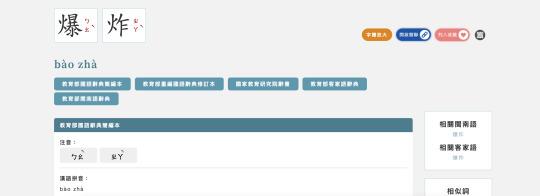
Continuing on, there’s some audio, definitions (in Chinese of course), and a couple examples.

Where this dictionary really shines is for chengyu. Here’s an example of what you get for the chengyu 听天由命.
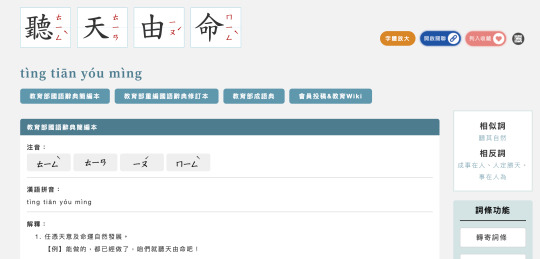
There’s almost too much here explaining the origin and history! Seriously, it’s too much content.
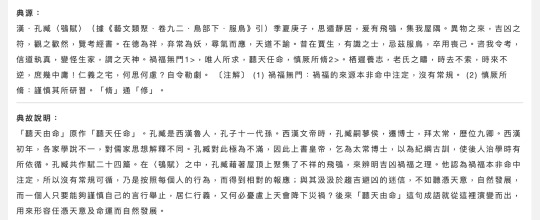
Here’s my favorite part: the example sentences. Some chengyu I’ve looked up don’t have this many example sentences, but some have even more.

Lastly, there’s even a comparison section to compare and contrast other similar chengyu.
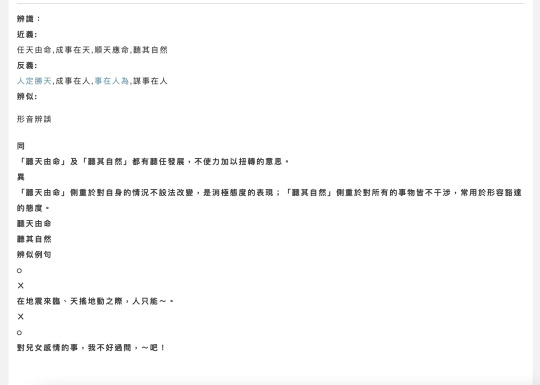
I’ve been doing a one year chengyu-a-day challenge for the past 10 months or so, and I found that for some chengyu, Pleco just didn’t cut it. There weren’t enough example sentences! I ended up stumbling across this resource, and it’s been so useful.
Pleco is usually still my first stop, but when I need more, I head over to https://pedia.cloud.edu.tw/ or https://dict.idioms.moe.edu.tw/ (the latter also has a lot of the same chengyu content but leaves some things out).
#chinese resources#chinese#mandarin#mandarin chinese#chinese language#language learning#learning languages#langblr#studyblr#dictionary#study resources#language study#language stuff#language blog#language#languages#foreign languages#learn chinese#learning chinese#study chinese#studying chinese#learn mandarin#learning mandarin#study mandarin#studying mandarin#chinese langblr#chinese studyblr#mandarin langblr#mandarin studyblr#chengyu
347 notes
·
View notes
Text
Fantasy Guide to Interiors



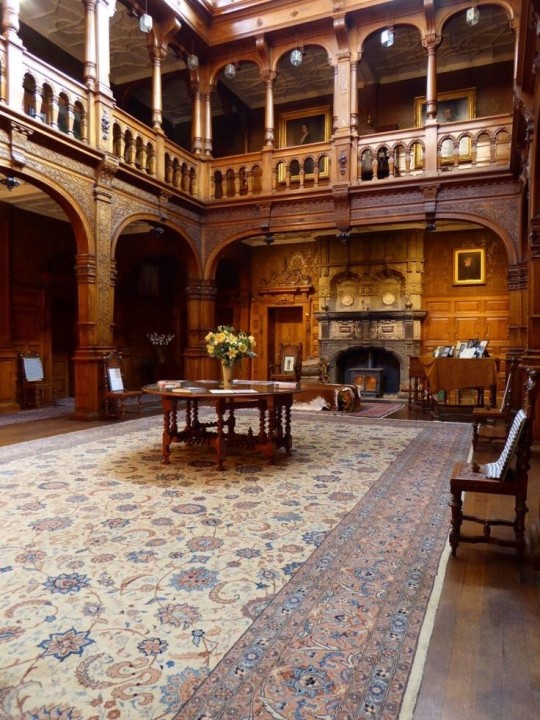
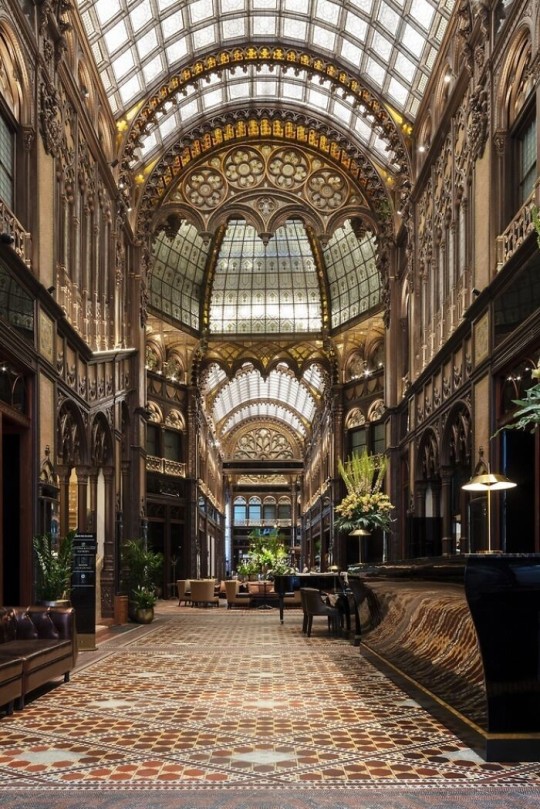
As a followup to the very popular post on architecture, I decided to add onto it by exploring the interior of each movement and the different design techniques and tastes of each era. This post at be helpful for historical fiction, fantasy or just a long read when you're bored.
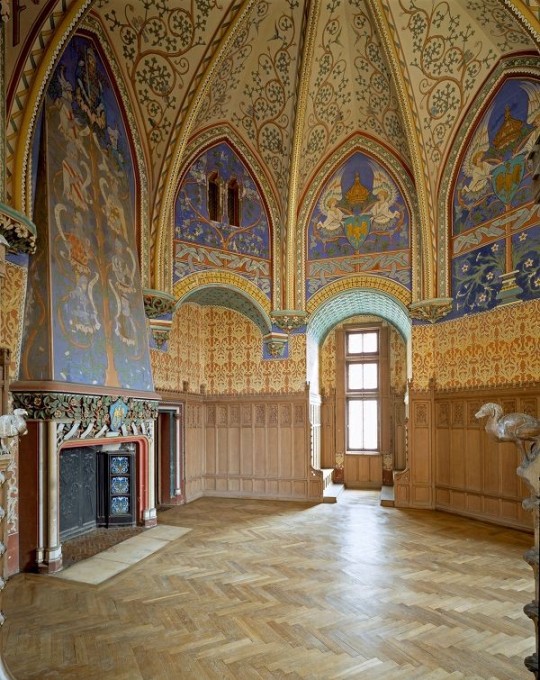


Interior Design Terms
Reeding and fluting: Fluting is a technique that consists a continuous pattern of concave grooves in a flat surface across a surface. Reeding is it's opposite.
Embossing: stamping, carving or moulding a symbol to make it stand out on a surface.
Paneling: Panels of carved wood or fabric a fixed to a wall in a continuous pattern.
Gilding: the use of gold to highlight features.
Glazed Tile: Ceramic or porcelain tiles coated with liquid coloured glass or enamel.
Column: A column is a pillar of stone or wood built to support a ceiling. We will see more of columns later on.
Bay Window: The Bay Window is a window projecting outward from a building.
Frescos: A design element of painting images upon wet plaster.
Mosaic: Mosaics are a design element that involves using pieces of coloured glass and fitted them together upon the floor or wall to form images.
Mouldings: ornate strips of carved wood along the top of a wall.
Wainscoting: paneling along the lower portion of a wall.
Chinoiserie: A European take on East Asian art. Usually seen in wallpaper.
Clerestory: A series of eye-level windows.
Sconces: A light fixture supported on a wall.
Niche: A sunken area within a wall.
Monochromatic: Focusing on a single colour within a scheme.
Ceiling rose: A moulding fashioned on the ceiling in the shape of a rose usually supporting a light fixture.
Baluster: the vertical bars of a railing.
Façade: front portion of a building
Lintel: Top of a door or window.
Portico: a covered structure over a door supported by columns
Eaves: the part of the roof overhanging from the building
Skirting: border around lower length of a wall
Ancient Greece
Houses were made of either sun-dried clay bricks or stone which were painted when they dried. Ground floors were decorated with coloured stones and tiles called Mosaics. Upper level floors were made from wood. Homes were furnished with tapestries and furniture, and in grand homes statues and grand altars would be found. Furniture was very skillfully crafted in Ancient Greece, much attention was paid to the carving and decoration of such things. Of course, Ancient Greece is ancient so I won't be going through all the movements but I will talk a little about columns.
Doric: Doric is the oldest of the orders and some argue it is the simplest. The columns of this style are set close together, without bases and carved with concave curves called flutes. The capitals (the top of the column) are plain often built with a curve at the base called an echinus and are topped by a square at the apex called an abacus. The entablature is marked by frieze of vertical channels/triglyphs. In between the channels would be detail of carved marble. The Parthenon in Athens is your best example of Doric architecture.
Ionic: The Ionic style was used for smaller buildings and the interiors. The columns had twin volutes, scroll-like designs on its capital. Between these scrolls, there was a carved curve known as an egg and in this style the entablature is much narrower and the frieze is thick with carvings. The example of Ionic Architecture is the Temple to Athena Nike at the Athens Acropolis.
Corinthian: The Corinthian style has some similarities with the Ionic order, the bases, entablature and columns almost the same but the capital is more ornate its base, column, and entablature, but its capital is far more ornate, commonly carved with depictions of acanthus leaves. The style was more slender than the others on this list, used less for bearing weight but more for decoration. Corinthian style can be found along the top levels of the Colosseum in Rome.
Tuscan: The Tuscan order shares much with the Doric order, but the columns are un-fluted and smooth. The entablature is far simpler, formed without triglyphs or guttae. The columns are capped with round capitals.
Composite: This style is mixed. It features the volutes of the Ionic order and the capitals of the Corinthian order. The volutes are larger in these columns and often more ornate. The column's capital is rather plain. for the capital, with no consistent differences to that above or below the capital.
Ancient Rome
Rome is well known for its outward architectural styles. However the Romans did know how to add that rizz to the interior. Ceilings were either vaulted or made from exploded beams that could be painted. The Romans were big into design. Moasics were a common interior sight, the use of little pieces of coloured glass or stone to create a larger image. Frescoes were used to add colour to the home, depicting mythical figures and beasts and also different textures such as stonework or brick. The Romans loved their furniture. Dining tables were low and the Romans ate on couches. Weaving was a popular pastime so there would be tapestries and wall hangings in the house. Rich households could even afford to import fine rugs from across the Empire. Glass was also a feature in Roman interior but windows were usually not paned as large panes were hard to make. Doors were usually treated with panels that were carved or in lain with bronze.
Ancient Egypt
Egypt was one of the first great civilisations, known for its immense and grand structures. Wealthy Egyptians had grand homes. The walls were painted or plastered usually with bright colours and hues. The Egyptians are cool because they mapped out their buildings in such a way to adhere to astrological movements meaning on special days if the calendar the temple or monuments were in the right place always. The columns of Egyptian where thicker, more bulbous and often had capitals shaped like bundles of papyrus reeds. Woven mats and tapestries were popular decor. Motifs from the river such as palms, papyrus and reeds were popular symbols used.
Ancient Africa
African Architecture is a very mixed bag and more structurally different and impressive than Hollywood would have you believe. Far beyond the common depictions of primitive buildings, the African nations were among the giants of their time in architecture, no style quite the same as the last but just as breathtaking.
Rwandan Architecture: The Rwandans commonly built of hardened clay with thatched roofs of dried grass or reeds. Mats of woven reeds carpeted the floors of royal abodes. These residences folded about a large public area known as a karubanda and were often so large that they became almost like a maze, connecting different chambers/huts of all kinds of uses be they residential or for other purposes.
Ashanti Architecture: The Ashanti style can be found in present day Ghana. The style incorporates walls of plaster formed of mud and designed with bright paint and buildings with a courtyard at the heart, not unlike another examples on this post. The Ashanti also formed their buildings of the favourite method of wattle and daub.
Nubian Architecture: Nubia, in modern day Ethiopia, was home to the Nubians who were one of the world's most impressive architects at the beginning of the architecture world and probably would be more talked about if it weren't for the Egyptians building monuments only up the road. The Nubians were famous for building the speos, tall tower-like spires carved of stone. The Nubians used a variety of materials and skills to build, for example wattle and daub and mudbrick. The Kingdom of Kush, the people who took over the Nubian Empire was a fan of Egyptian works even if they didn't like them very much. The Kushites began building pyramid-like structures such at the sight of Gebel Barkal
Japanese Interiors
Japenese interior design rests upon 7 principles. Kanso (簡素)- Simplicity, Fukinsei (不均整)- Asymmetry, Shizen (自然)- Natural, Shibumi (渋味) – Simple beauty, Yugen (幽玄)- subtle grace, Datsuzoku (脱俗) – freedom from habitual behaviour, Seijaku (静寂)- tranquillity.
Common features of Japanese Interior Design:
Shoji walls: these are the screens you think of when you think of the traditional Japanese homes. They are made of wooden frames, rice paper and used to partition
Tatami: Tatami mats are used within Japanese households to blanket the floors. They were made of rice straw and rush straw, laid down to cushion the floor.
Genkan: The Genkan was a sunken space between the front door and the rest of the house. This area is meant to separate the home from the outside and is where shoes are discarded before entering.
Japanese furniture: often lowest, close to the ground. These include tables and chairs but often tanked are replaced by zabuton, large cushions. Furniture is usually carved of wood in a minimalist design.
Nature: As both the Shinto and Buddhist beliefs are great influences upon architecture, there is a strong presence of nature with the architecture. Wood is used for this reason and natural light is prevalent with in the home. The orientation is meant to reflect the best view of the world.
Islamic World Interior
The Islamic world has one of the most beautiful and impressive interior design styles across the world. Colour and detail are absolute staples in the movement. Windows are usually not paned with glass but covered in ornate lattices known as jali. The jali give ventilation, light and privacy to the home. Islamic Interiors are ornate and colourful, using coloured ceramic tiles. The upper parts of walls and ceilings are usually flat decorated with arabesques (foliate ornamentation), while the lower wall areas were usually tiled. Features such as honeycombed ceilings, horseshoe arches, stalactite-fringed arches and stalactite vaults (Muqarnas) are prevalent among many famous Islamic buildings such as the Alhambra and the Blue Mosque.
Byzantine (330/395–1453 A. D)
The Byzantine Empire or Eastern Roman Empire was where eat met west, leading to a melting pot of different interior designs based on early Christian styles and Persian influences. Mosaics are probably what you think of when you think of the Byzantine Empire. Ivory was also a popular feature in the Interiors, with carved ivory or the use of it in inlay. The use of gold as a decorative feature usually by way of repoussé (decorating metals by hammering in the design from the backside of the metal). Fabrics from Persia, heavily embroidered and intricately woven along with silks from afar a field as China, would also be used to upholster furniture or be used as wall hangings. The Byzantines favoured natural light, usually from the use of copolas.
Indian Interiors
India is of course, the font of all intricate designs. India's history is sectioned into many eras but we will focus on a few to give you an idea of prevalent techniques and tastes.
The Gupta Empire (320 – 650 CE): The Gupta era was a time of stone carving. As impressive as the outside of these buildings are, the Interiors are just as amazing. Gupta era buildings featured many details such as ogee (circular or horseshoe arch), gavaksha/chandrashala (the motif centred these arches), ashlar masonry (built of squared stone blocks) with ceilings of plain, flat slabs of stone.
Delhi Sultanate (1206–1526): Another period of beautifully carved stone. The Delhi sultanate had influence from the Islamic world, with heavy uses of mosaics, brackets, intricate mouldings, columns and and hypostyle halls.
Mughal Empire (1526–1857): Stonework was also important on the Mughal Empire. Intricately carved stonework was seen in the pillars, low relief panels depicting nature images and jalis (marble screens). Stonework was also decorated in a stye known as pietra dura/parchin kari with inscriptions and geometric designs using colored stones to create images. Tilework was also popular during this period. Moasic tiles were cut and fitted together to create larger patters while cuerda seca tiles were coloured tiles outlined with black.
Chinese Interiors
Common features of Chinese Interiors
Use of Colours: Colour in Chinese Interior is usually vibrant and bold. Red and Black are are traditional colours, meant to bring luck, happiness, power, knowledge and stability to the household.
Latticework: Lattices are a staple in Chinese interiors most often seen on shutters, screens, doors of cabinets snf even traditional beds.
Lacquer: Multiple coats of lacquer are applied to furniture or cabinets (now walls) and then carved. The skill is called Diaoqi (雕漆).
Decorative Screens: Screens are used to partition off part of a room. They are usually of carved wood, pained with very intricate murals.
Shrines: Spaces were reserved on the home to honour ancestors, usually consisting of an altar where offerings could be made.
Of course, Chinese Interiors are not all the same through the different eras. While some details and techniques were interchangeable through different dynasties, usually a dynasty had a notable style or deviation. These aren't all the dynasties of course but a few interesting examples.
Song Dynasty (960–1279): The Song Dynasty is known for its stonework. Sculpture was an important part of Song Dynasty interior. It was in this period than brick and stone work became the most used material. The Song Dynasty was also known for its very intricate attention to detail, paintings, and used tiles.
Ming Dynasty(1368–1644): Ceilings were adorned with cloisons usually featuring yellow reed work. The floors would be of flagstones usually of deep tones, mostly black. The Ming Dynasty favoured richly coloured silk hangings, tapestries and furnishings. Furniture was usually carved of darker woods, arrayed in a certain way to bring peace to the dwelling.
Han Dynasty (206 BC-220 AD): Interior walls were plastered and painted to show important figures and scenes. Lacquer, though it was discovered earlier, came into greater prominence with better skill in this era.
Tang Dynasty (618–907) : The colour palette is restrained, reserved. But the Tang dynasty is not without it's beauty. Earthenware reached it's peak in this era, many homes would display fine examples as well. The Tang dynasty is famous for its upturned eaves, the ceilings supported by timber columns mounted with metal or stone bases. Glazed tiles were popular in this era, either a fixed to the roof or decorating a screen wall.
Romanesque (6th -11th century/12th)
Romanesque Architecture is a span between the end of Roman Empire to the Gothic style. Taking inspiration from the Roman and Byzantine Empires, the Romanesque period incorporates many of the styles. The most common details are carved floral and foliage symbols with the stonework of the Romanesque buildings. Cable mouldings or twisted rope-like carvings would have framed doorways. As per the name, Romansque Interiors relied heavily on its love and admiration for Rome. The Romanesque style uses geometric shapes as statements using curves, circles snf arches. The colours would be clean and warm, focusing on minimal ornamentation.
Gothic Architecture (12th Century - 16th Century)
The Gothic style is what you think of when you think of old European cathedrals and probably one of the beautiful of the styles on this list and one of most recognisable. The Gothic style is a dramatic, opposing sight and one of the easiest to describe. Decoration in this era became more ornate, stonework began to sport carving and modelling in a way it did not before. The ceilings moved away from barreled vaults to quadripartite and sexpartite vaulting. Columns slimmed as other supportive structures were invented. Intricate stained glass windows began their popularity here. In Gothic structures, everything is very symmetrical and even.
Mediaeval (500 AD to 1500)
Interiors of mediaeval homes are not quite as drab as Hollywood likes to make out. Building materials may be hidden by plaster in rich homes, sometimes even painted. Floors were either dirt strewn with rushes or flagstones in larger homes. Stonework was popular, especially around fireplaces. Grand homes would be decorated with intricate woodwork, carved heraldic beasts and wall hangings of fine fabrics.
Renaissance (late 1300s-1600s)
The Renaissance was a period of great artistry and splendor. The revival of old styles injected symmetry and colour into the homes. Frescoes were back. Painted mouldings adorned the ceilings and walls. Furniture became more ornate, fixed with luxurious upholstery and fine carvings. Caryatids (pillars in the shape of women), grotesques, Roman and Greek images were used to spruce up the place. Floors began to become more intricate, with coloured stone and marble. Modelled stucco, sgraffiti arabesques (made by cutting lines through a layer of plaster or stucco to reveal an underlayer), and fine wall painting were used in brilliant combinations in the early part of the 16th century.
Tudor Interior (1485-1603)
The Tudor period is a starkly unique style within England and very recognisable. Windows were fixed with lattice work, usually casement. Stained glass was also in in this period, usually depicting figures and heraldic beasts. Rooms would be panelled with wood or plastered. Walls would be adorned with tapestries or embroidered hangings. Windows and furniture would be furnished with fine fabrics such as brocade. Floors would typically be of wood, sometimes strewn with rush matting mixed with fresh herbs and flowers to freshen the room.
Baroque (1600 to 1750)
The Baroque period was a time for splendor and for splashing the cash. The interior of a baroque room was usually intricate, usually of a light palette, featuring a very high ceiling heavy with detail. Furniture would choke the room, ornately carved and stitched with very high quality fabrics. The rooms would be full of art not limited to just paintings but also sculptures of marble or bronze, large intricate mirrors, moldings along the walls which may be heavily gilded, chandeliers and detailed paneling.
Victorian (1837-1901)
We think of the interiors of Victorian homes as dowdy and dark but that isn't true. The Victorians favoured tapestries, intricate rugs, decorated wallpaper, exquisitely furniture, and surprisingly, bright colour. Dyes were more widely available to people of all stations and the Victorians did not want for colour. Patterns and details were usually nature inspired, usually floral or vines. Walls could also be painted to mimic a building material such as wood or marble and most likely painted in rich tones. The Victorians were suckers for furniture, preferring them grandly carved with fine fabric usually embroidered or buttoned. And they did not believe in minimalism. If you could fit another piece of furniture in a room, it was going in there. Floors were almost eclusively wood laid with the previously mentioned rugs. But the Victorians did enjoy tiled floors but restricted them to entrances. The Victorians were quite in touch with their green thumbs so expect a lot of flowers and greenery inside. with various elaborately decorated patterned rugs. And remember, the Victorians loved to display as much wealth as they could. Every shelf, cabinet, case and ledge would be chocked full of ornaments and antiques.
Edwardian/The Gilded Age/Belle Epoque (1880s-1914)
This period (I've lumped them together for simplicity) began to move away from the deep tones and ornate patterns of the Victorian period. Colour became more neutral. Nature still had a place in design. Stained glass began to become popular, especially on lampshades and light fixtures. Embossing started to gain popularity and tile work began to expand from the entrance halls to other parts of the house. Furniture began to move away from dark wood, some families favouring breathable woods like wicker. The rooms would be less cluttered.
Art Deco (1920s-1930s)
The 1920s was a time of buzz and change. Gone were the refined tastes of the pre-war era and now the wow factor was in. Walls were smoother, buildings were sharper and more jagged, doorways and windows were decorated with reeding and fluting. Pastels were in, as was the heavy use of black and white, along with gold. Mirrors and glass were in, injecting light into rooms. Gold, silver, steel and chrome were used in furnishings and decor. Geometric shapes were a favourite design choice. Again, high quality and bold fabrics were used such as animal skins or colourful velvet. It was all a rejection of the Art Noveau movement, away from nature focusing on the man made.
Modernism (1930 - 1965)
Modernism came after the Art Deco movement. Fuss and feathers were out the door and now, practicality was in. Materials used are shown as they are, wood is not painted, metal is not coated. Bright colours were acceptable but neutral palettes were favoured. Interiors were open and favoured large windows. Furniture was practical, for use rather than the ornamentation, featuring plain details of any and geometric shapes. Away from Art Deco, everything is straight, linear and streamlined.
#This took forever#I'm very tired#But enjoy#I covered as much as I could find#Fantasy Guide to interiors#interior design#Architecture#writings#writing resources#Writing reference#Writing advice#Writer's research#writing research#Writer's rescources#Writing help#Mediaeval#Renaissance#Chinese Interiors#Japanese Interiors#Indian interiors#writing#writeblr#writing reference#writing advice#writer#spilled words#writers
3K notes
·
View notes
Text
i haven't seen anyone talk about it before, but there's a site called 21st Century Chinese Poetry that has a massive collection of contemporary chinese poetry, including english translations thereof, for anyone who, like me, is interested in poetry but may feel a bit intimidated by the more literary nature of classical poetry. currently, they have poetry from between 2000-2021, and i, personally, have rather enjoyed poking around the site.
#chinese langblr#mandarin langblr#chinese#chinese language#mandarin#mandarin chinese#langblr#language learning#langblr resources#resources#汉语#indigo ink
724 notes
·
View notes
Text
This is the lovely post by MoonIvy that inspired me to get myself back into reading chinese by the way:
And this is MoonIvy's other amazing post, which includes a list of everything they read so far in order of difficulty which is a great reference list if you are looking for something to try, and includes some suggestions on listening study things you can try too.
MoonIvy is part of the group managing the Heavenly Path site I keep mentioning, that just has so many phenomenally organized media recommendations, a good guide to starting to read, and lots of linked resources:
#rant#reading#resources#chinese resources#rec list#so in these posts moonivy mentions some good starting places for HSK 4 people to push into reading#and i agree at about hsk 4 you can handle 1 a ton of graded readers (from 500 hanzi to 2000 as you go)#and 2 u can eventually handle native novels at hsk 4. thats when i pushed into native novels#i would say though. my own difference in learning#is i personally found it motivating and enjoyable to read WAY above my level at times.#i personally always go between 1 easier thing for myself and 1 harder thing to read. i felt that kept my#reading level both progressively increase while also giving me easier stuff to practice extensive reading#and for me it was HIGHLY motivating to read 100 pages of priest in print 2 years in#HIGHLY motivatkng to read tian ya ke with a click dictilnary 10 months in.#to see chapters go from 1.5 hours to read to 50 minutes to 40 minutes to 25 minutes.#so for me. i would say if you WANT to read something way above your level? just go ahead#you can always bounce between easier and harder stuff#i find a good balance worked better for me. and also i tend to learn better when massively challenged ToT#idk why i think its just cause its familiar. id read my parents novels at age 8. ToT it feels#more like how i leafned my native language to simply read my foreign language the same#though i know it demotivates some people. in contrast i find keeping some harder stuff on hand#reminds me to challenge myself and not idle at the level im at.#so i say? assume u can do ANYTHING with success. and do it. and when it burns u out or is not fun anymore?#go do something easier u Know is Easy. (and it sure will feel easy after the Anything before lol)#then u get confidence doing it easy. and remember ur#still capable of Anything so try again when ur ready.
187 notes
·
View notes
Text
The 然's
突然,虽然,忽然. and the other 然's can often get mixed up, so here's a quick explanation of some of the most common ones!
突然 (Túrán): This means suddenly or unexpectedly
居然 (Jūrán): This kind of means suddenly, but more in the sense of "surprisingly" or to suggest disbelief at something that happened.
忽然 (Hūrán): This also means suddenly or unexpectedly, but it has a more stronger connotation.
既然 (Jìrán): This is a conjunction meaning "since" or "now that"
既然the weather is great, let's go out!
既然 you aren't busy, let's go watch a movie.
不然 (Bùrán): This means "otherwise" or "or else";
You should study, 不然 you won't do well on the exam.
虽然 (Suīrán): This means although or even though.
虽然 I'm not good at singing, I still like to go to the karaoke.
当然 (Dāngrán): 当然 means certainly or definitely and can be used as a reply:
Can you help me with A? 当然!
自然 (Zìrán): This can mean nature or naturally.
China's 自然 is very beautiful.
She speaks Chinese 得很自然.
仍然 (Réngrán): This can mean "still" or "yet".
I仍然 haven't read that book.
依然 (Yīrán): Similar to 仍然, this also means still" or "yet" but it's usually used in more formal and literary works, whereas 仍然 is more often used in spoken language.
果然 (Guǒrán): 果然 can be used to mean "indeed" or "as expected"
This movie is 果然 interesting.
竟然 (Jìngrán): This is an adverb used to suggest surprise or something unexpected.
He竟然forgot her birthday.
显然 (Xiǎnrán): This means "clearly" or "obviously".
This soup 显然 hot.
偶然 (Ǒurán): This means "accidentally" or "by chance".
We 偶然 met at the same cafe.
How many other 然's do you know about? Drop a comment!
#slavic roots western mind#student life#student#study blog#college#college life#travel blog#aesthetic#studyblr#study motivation#chinese#china#study in china#life in china#learn chinese#chinese grammar#grammar#vocabulary#chinese vocabulary#chinese verbs#verbs#verb#chinese studyblr#mandarin langblr#mandarin#mandarin chinese#chinese language#language learning#chinese langblr#language resources
74 notes
·
View notes